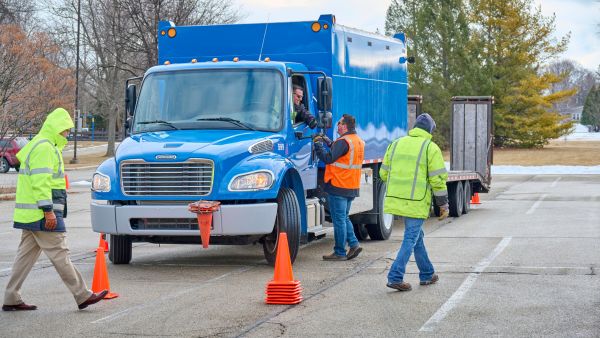Safe Driving Equals Smart Business
January 26, 2024

The value of effective driver training may not always be clear, however preventative programs have been proven to reduce reactive expenses. Efficiency-focused companies want to invest in programs that support their goals and corporate responsibilities. If you need stakeholder buy in to support your driver training initiatives, consider all the ways to demonstrate return on investment, it’s simply a safe and smart business decision.
FEWER ACCIDENTS & INJURIES
Driver training that includes defensive driving and injury prevention can reduce accidents and injuries. This is because the training provides your drivers with the knowledge and skill necessary to operate defensively, safely, and in compliance with the traffic codes, and to work safely around your equipment. An effective training program will also establish your expectations. Providing the training and taking it seriously shows your drivers you are serious about the topics. This is a “force multiplier,” in that what your drivers see as important to you, becomes important to them.
LESS VEHICLE DAMAGE
If your drivers are trained on vehicle inspections, safe and compliant driving, and how to operate the equipment properly, your drivers will not be operating vehicles with minor defects that become major ones. They also will not be denting, scaping, or crashing your vehicles. Finally, they will not have bad habits that abuse or damage the mechanical systems of the vehicles. This will reduce the amount of vehicle damage and the number of defects your maintenance group or vendors have to repair, and this in turn drives down your maintenance and repair costs.
FEWER COSTLY VIOLATIONS
Drivers that know and understand the traffic codes and safety regulations are far less likely to violation them. How do you get your drivers to know and understand the traffic codes and safety regulations? Through a training program that includes these topics as part of the initial driver training (orientation), ongoing training (safety meetings and ongoing training and communications), and corrective action training.
INCREASED BRAND PROTECTION
The motoring public and your customers do not remember the commercial vehicle that passed them or that they passed that was being operated safely and compliantly. However, they do remember the ones that were not being operated safely and compliantly, or that were involved in serious preventable incidents in their area. To make sure the motoring public and your customers see you as a good company, train your drivers on all aspects of doing their job, track their performance, and do retraining when a problem with a driver appears.
LOWER INSURANCE RATES
One of the key considerations when an insurance company sets your premiums is your number of accidents and money lost to the accidents. Another key consideration is your driver’s compliance with the traffic codes and safety regulations. So how do you achieve a low accident rate, low accident losses, and a low violation rate? By continuously training your drivers on vehicle inspections, defensive driving, the traffic codes, and the safety regulations.
INCREASED LITIGATION PROTECTION
During litigation, the other side will use the traffic code, safety regulations, and your company policies as the roadmap to prove you were negligent. To lead the other side to where you want them to be, you need to operate safely and compliantly daily, and make sure your drivers do as well. Training your drivers, doing scheduled ongoing training, and tracking your drivers’ performance and retraining when necessary is how you get the roadmap to lead to where you want it to go during litigation.
LESS DOWNTIME
Downtime, whether due to equipment failure, an accident, or being placed out of service is costly when you consider the cost of getting going again, the lost revenue, and the possible loss of a customer. Training drivers to conduct proper pre-trips, and to operate defensively, safely, and in compliance with the safety regulations is how you prevent many of these losses.
LESS LOST OR DAMAGED FREIGHT
No one want to lose or damage freight. However, a driver having the knowledge and skills necessary to deliver loads without loss (such as from misloads and theft), damage, or delay does not just happen. Training on safe loading, loading procedures, cargo securement, and cargo security is how these problems, and the losses that come with these problems, are prevented.
IMPROVED DRIVER RETENTION
In survey after survey, one key component to driver retention is the company treating the driver well. Part of this is training the driver, so the driver can do the job as expected. An untrained driver will tend to make errors. These errors then lead to negative contact with someone at the company (such as human resources or safety). On the other hand, doing the job as expected keeps the driver out of the safety or human resources office, which keeps your drivers happier with their jobs, allowing your other retention efforts can make headway.
BETTER CSA SCORES
Scores in the Compliance, Safety, Accountability (CSA) system are based on violations and crashes. The way to prevent both of these is to train your drivers, track their performance, and retrain them when necessary. Key areas your drivers must be trained in to prevent issues with CSA includes the traffic codes and defensive driving (to prevent unsafe driving violations and crashes), the safety regulations (to prevent hours of service, controlled substance and alcohol, hazardous materials, and driver fitness violations), and vehicle inspections (to prevent vehicle violations).
Driver safety training is a worthwhile investment, if you have questions or need assistance to get started, we can help you implement effective training for any situation.